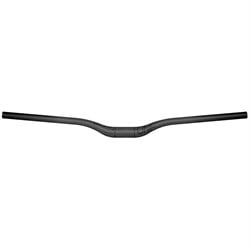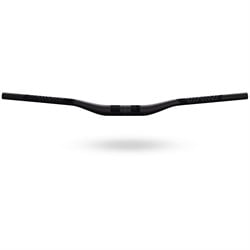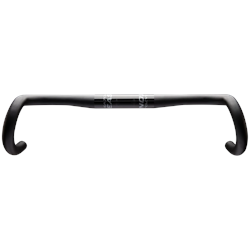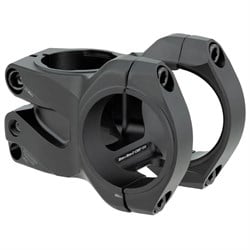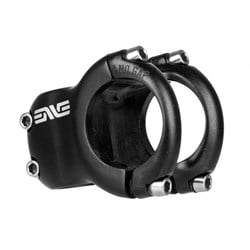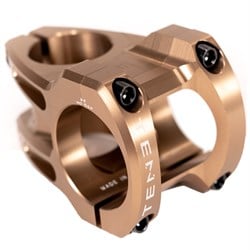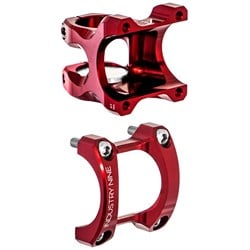How to Choose Mountain Bike Handlebars
By: evo | March 22, 2023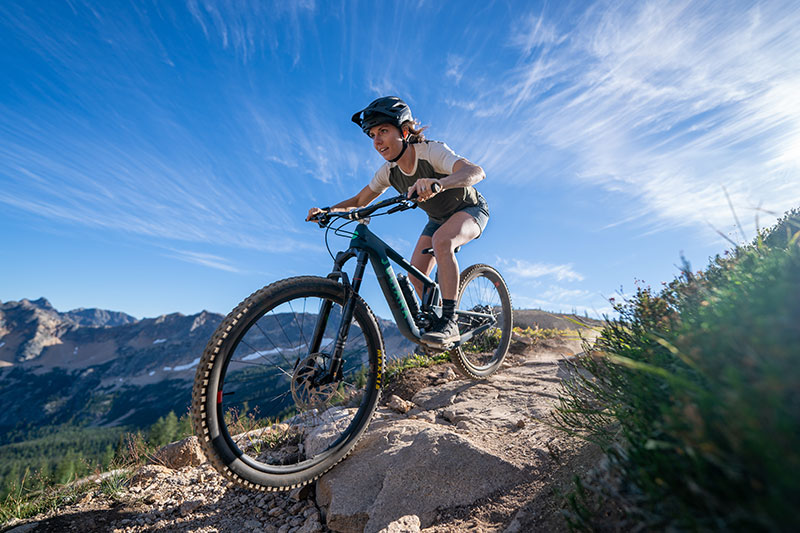
If you’ve never purchased mountain bike handlebars before, congratulations, you’re about to learn about a key part of your bike that you may not have given any thought to. Handlebars are simple, right? They let you hold onto your bike and make it turn when you want to. But there are a lot of factors at play. So hold on tight, we’ll break down every choice you’ll need to make when it comes time to buy mountain bike handlebars.
But first, the short version for folks who want the “what” without the “how.” Most riders will be just fine buying mountain bike handlebars the same diameter as whatever was on their bike beforehand, with a 20 to 30 mm rise, 5° upsweep, and 8° backsweep, that are made out of aluminum and come stock at 800 mm wide and can be cut down. That’s the barest bones, most simplified set of standards. But why settle for a "standard" handlebar when you could find one perfect for you and your riding style? We’ll break those stats down and explain how they affect your bike’s handling, so that you can find handlebars that gel perfectly with the rest of your ride.
Handlebar Diameter
The diameter of your handlebars refers to the outside diameter of the bar at the center, where the stem clamps it. There are only two options for mountain bikers: 31.8 mm or 35 mm. Why do we need two options? Originally all bikes came with 31.8 mm handlebars, and most people were happy. But along the way, as bikes and forks became stiffer, folks realized that those smaller diameter bars flexed quite a bit and introduced a vague sensation into their bike’s handling. So the 35 mm diameter bar standard was created. The wider diameter makes the bars much stiffer without an appreciable weight gain. Also, 31.8 mm and 35 mm sizes taper down to the same width at the grips, so the only difference is the size stem you run.
For most riders, 31.8 mm bars are entirely adequate. But, if you’re a bigger rider who’s pushing hard in technical terrain, you might appreciate 35 mm bars. On the other hand, some folks find 35 mm bars to feel a bit harsher, they appreciate the added flex of the smaller bar and find it helps quiet trail noise. For most riders, however, the difference is so slight it’s nearly impossible to tell by feel alone. So, generally, get whichever bar diameter your current stem works with. It should say right on the stem, and if it doesn’t, your local bike shop will be able to tell.
Handlebar Material
Once you’ve figured out your diameter, you’re faced with another choice: Carbon or Aluminum? This one is pretty straightforward as well. Carbon MTB handlebars are more expensive, lighter, and stiffer. Aluminum MTB handlebars are cheaper, heavier, and usually less stiff. Again, the differences here are subtle. Most people will be unable to tell the difference between carbon and aluminum by feel alone. So, if you’re balling out or trying to build a super light bike, sure, go carbon. But if you’re looking to spend that money on riding trips instead of parts, there’s no significant performance penalty to aluminum handlebars. Either way, make sure to use a torque wrench and friction past when you’re installing your stem, grips, and controls. Over-torquing bars can cause them to fail at the worst times.
Handlebar Width
Handlebar width is probably the factor you’ll notice the most just riding a bike around the parking lot. How far apart your hands are changes how the whole bike feels and steers. Most bars come stock at 800 mm wide, with markings to cut them down to the desired width. Generally speaking, wider bars improve stability, and narrower bars improve maneuverability. Cross-country riders are more likely to be at the narrower end of the scale, while trail, enduro, and downhill riders tend to prefer wider handlebars.
The final width you end up with will take into account your height, your wingspan, the reach and seat tube angle of your bike, your stem length, and your riding style. So we won’t dive into all of that here. Instead, we’ll say that for most bike riders, 800 mm bars work great for folks over 6’ tall, plus or minus a few inches. As the rider gets shorter, the bars should get narrower. Look at the bars you’ve used in the past, and use them as a starting point for determining your desired width. But don’t be scared to leave your bars wide for a while and experiment. You may find that you like them a bit wider, and you can always cut them down later.
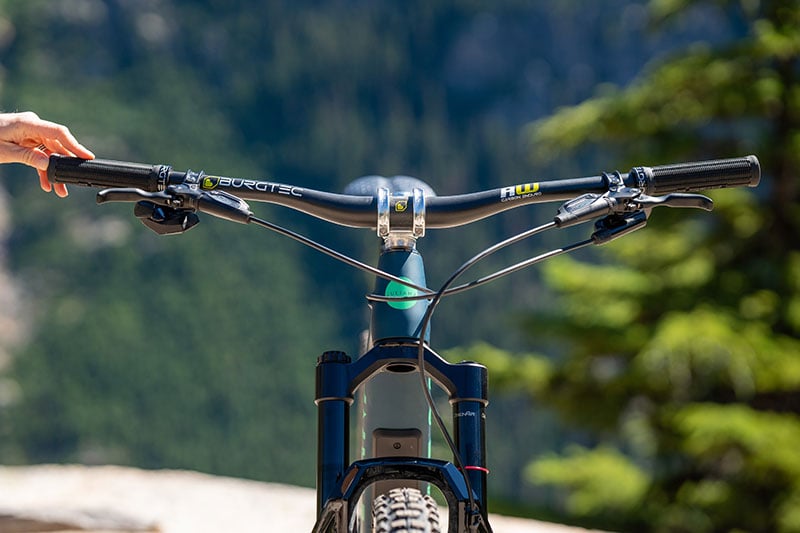
Rise
Most mountain bike bars are not flat, but have grips that are higher than the center of the bar. This is called the rise, and it helps the bike handle naturally. How much rise you end up running is a very personal choice. Higher rise bars give you a more rearward posture over the bike, which can help you stay centered on steep descents. Conversely, lower rise bars pull you over the front of the bike and make it handle better on steep climbs. Most folks will do best with something in the middle of the road, in the 20 mm range. If you’re building a pure XC bike, think about going lower. For a pure downhill bike, go higher. Either way, you can raise handlebars on a mountain bike by moving headset spacers around, so the overall height is easy to tweak.
Upsweep
Most mountain bikes' grips aren’t perfectly parallel to the ground. Instead, they tilt up from the center of the bar slightly. This allows your wrists to find a more natural position on the bar and allows you to use your muscles more efficiently. Most bars have an upsweep of around 5°. That should work for most people. The one exception is if you’ve had a wrist injury that affects mobility. For those people, sometimes bars with more or less sweep can make sense, and the only way to find out is to play around and figure out what is more comfortable. You can adjust your upsweep to some extent by rolling the bars forward or back. This will also change your backsweep, but feel free to mess around with different bar positions to find the one that is most comfortable for you.
Backsweep
Backsweep is the same as upsweep, it just goes back toward you instead of up from the stem. That means your hands are further back on the bike than the front of the stem, putting them more in line with the fork. Most bars have a backsweep in the 6 to 10° range, with most stock options splitting the difference at 8°. If you don’t have a preference, 8° will treat you just fine. Just like upsweep, the only real reason to try different dimensions is if you’re dealing with pain or discomfort while riding. Everyone’s bodies are built differently, and we all interact with the bike differently, so don’t be afraid to modify your gear choices to make your body more comfortable. That’s the point of having choices.
Compliance & Vibration Damping
In recent years, manufacturers have focused on adding greater vibration damping to their bars. Essentially the goal is to build mountain bike handlebars with the vertical stiffness of 35 mm bars but the chatter-dampening properties of 31.8 mm bars. These technologies make a subtle difference for most riders. However, a handlebar with more compliance could be just the ticket if you are dealing with wrist pain and fatigue after chattery downhills. At the very least, you’re not losing any performance by going to a bar with specific vibration-damping properties. But getting cushier grips and adjusting your suspension to help deal with those issues is also worth it. Usually, hand pain on the bike is caused by a combination of issues, including grips, bars, suspension, tire pressure, and the orientation of your controls, so adjust each of those one at a time to help mitigate any discomfort.
Choosing a Stem
Sweet! You found a great new bar, now you just need a stem so you can bolt it onto your bike. Well….that’s a whole new can of worms. For now, just use the stem that came with your bike, since you used this guide, your new bars are the right diameter to fit into it, right?
If you’re dead set on getting a new stem, here are the basics: just like bars, stems come in various lengths and rises. A stem with more rise will help keep your front end up on steep descents, while a negative rise stem will give you more climbing precision. Your bike was probably designed around a specific length stem. Look at the stem length it comes with stock, and keep that number in mind. It’s a good idea not to deviate more than 10 mm from the stock length in either direction. So if you want a more relaxed handing bike that’s more stable at speed, go with a 10 mm shorter stem. Or, if you want to optimize your bike for climbing and want to stretch out your arms and torso a little, get a 10 mm longer stem. Either way, use a torque wrench when installing it to your fork and bolting your bars to it.
FAQ
How do you raise handlebars on a mountain bike?
To raise the handlebars on a mountain bike, you can either install a stem with a higher angle or purchase a stem with a higher stack height. Additionally, you can add spacers between the stem and the headset to increase the height. Once you have made the necessary adjustments, make sure that the handlebars are securely tightened to prevent any accidents while riding.How do you measure mountain bike handlebars?
To measure mountain bike handlebars, you will need to measure the distance between the center of the handlebar where it attaches to the stem and the end of the handlebar. This measurement is typically referred to as the width of the handlebar. You can use a tape measure or a ruler to take this measurement.Why are mountain bike handlebars so wide?
Mountain bike handlebars are wider than traditional road bike handlebars because they provide more control and stability when riding off-road. The extra width allows riders to have more leverage when steering and also provides more space for mounting accessories like lights and GPS units.How do you change handlebar grips on a mountain bike?
To change handlebar grips on a mountain bike, first, remove the old grips by loosening the screws or cutting them off with a utility knife. Next, clean the handlebar with rubbing alcohol and slide the new grips onto the handlebar. Finally, secure the new grips by tightening the screws or pushing the bar end plugs into place.How do you cut mountain bike handlebars?
To cut mountain bike handlebars, first, remove the grips and any accessories like brake levers or shifters. Then, measure the desired length and mark the handlebar with a piece of tape or a marker. Use a saw guide to ensure a straight cut and cut the handlebar to the desired length with a hacksaw or a pipe cutter. Finally, use a deburring tool or sandpaper to smooth out any rough edges.What are the most important factors to consider when choosing mountain bike handlebars?
There are several factors to consider when choosing mountain bike handlebars, including material, width, rise, sweep, and clamp diameter. The material can affect the weight, strength, and stiffness of the handlebars, while the width, rise, and sweep can affect your riding position and comfort. The clamp diameter is also important as it needs to match the stem you are using.How do I determine the appropriate width and rise for my mountain bike handlebars?
The appropriate width and rise for your mountain bike handlebars depend on your riding style, body type, and personal preference. Generally, wider handlebars offer more control and stability, while narrower ones are more aerodynamic. The rise of the handlebars can affect your riding position, with higher rise bars offering a more upright position and lower rise bars providing a more aggressive position.Are there different types of materials used for mountain bike handlebars, and what are the pros and cons of each?
There are different types of materials used for mountain bike handlebars, including aluminum, carbon fiber, and titanium. Aluminum is the most common material and is relatively affordable and durable. Carbon fiber is lighter and more expensive, offering a more comfortable ride but may not be as durable as aluminum. Titanium is the most expensive, and is known for its strength, durability, and comfort.Can I install new handlebars on my mountain bike myself, or should I have a professional do it?
It is possible to install new handlebars on your mountain bike yourself, but it is recommended to have a professional do it, especially if you are not experienced with bike maintenance. A professional bike mechanic can ensure that the handlebars are installed correctly and safely.How can I tell if my mountain bike handlebars are the right fit for me, and what should I do if they aren't?
The right fit for your mountain bike handlebars will depend on your riding style, body type, and personal preference. You can tell if they are the right fit if they are comfortable and provide good control and stability. If they are not the right fit, you may experience discomfort, pain, or lack of control. If this happens, you should consider adjusting the width, rise, or sweep of the handlebars, or consult a professional bike fitter to help you find the right fit.Learn More With Our Other Bike Guides:
- How to Choose a Mountain Bike
- Mountain Bike Sizing and Fit Guide
- How to Get Started Mountain Biking
- How to Choose a Mountain Bike Wheel Size
- Mountain Bikes Suspension Basics
- How to Choose a Mountain Bike Dropper Post
- How to Choose Mountain Bike Tires
- How to Choose Mountain Bike Handlebars
- How to Choose Mountain Bike Pedals
- How to Change Bike Pedals
- How to Clean a Mountain Bike
- How to Bleed SRAM Brakes
- How to Bleed Shimano Brakes
- How to Convert to Tubeless Tires
- How to Replace Internal Cable Housing
- How to Adjust Your Rear Derailleur
- Shimano Groupset Hierarchy Explained
- SRAM Groupset Hierarchy Explained
- SRAM vs Shimano Groupsets Compared
- Women's Mountain Bike Buyer's Guide
- What to Bring Mountain Biking
- What to Wear Mountain Biking
- How to Choose MTB Knee Pads
- Gravel Bikes - How To Get Started Gravel Biking
- Electric Mountain Bike Buyer's Guide
- Classes of eBikes
- Bike Helmet Size & Fit Guide
- How to Choose Bike Shoes
- Travel Guides - Where to Mountain Bike
- Travel Guides - Where to Ride eBikes
Learn About our Favorite Bike Gear:
The Best Women's Mountain Bikes
The Best Electric Mountain Bikes
The Best Mountain Bikes for Beginners
The Best Mountain Bikes Under $3,000
The Best Trail Bikes
The Best Enduro Bikes
The Best Gravel Bikes
The Best Mountain Bike Helmets
The Best Full Face MTB Helmets
The Best Mountain Bike Knee Pads
The Best Mountain Bike Elbow Pads
The Best Mountain Bike Shorts
The Best Women's Bike Shorts
The Best Mountain Bike Pants
The Best Mountain Bike Jerseys
The Best Mountain Bike Accessories
The Best Value Mountain Bike Helmets
The Best Dropper Posts
The Best Mountain Bike Forks
The Best Mountain Bike Stems
The Best Padded Mountain Bike Shorts
The Best Mountain Bikes Handlebars
The Best Gifts for Mountain Bikers
The Best Mountain Bike Gloves
The Best Mountain Bike Socks
The Best MTB Fanny Packs
The Best Mountain Bike Backpacks
The Best Clipless Mountain Bike Shoes
The Best Flat Pedal MTB Bike Shoes
The Best Mountain Bike Tires
The Best Mountain Bike Flat Pedals
The Best Bike Racks
The Best Bike Glasses
The Best Bike Goggles
The Best Women's Mountain Bike Jerseys
The Best Tailgate Bike Pads
The Best Bike Trainers
The Best Hitch Bike Racks
The Best Clipless MTB Pedals
The Best Mountain Bikes Handlebar Bags
The Best Mountain Bike Saddles
The Best MTB Wheels
The Best MTB Grips
The Best Mountain Bike Multi Tools
The Best Mountain Bike Seat Bags
Popular Bike Searches
This is evo. We are a ski, snowboard, wake, skate, bike, surf, camp, and clothing online retailer with physical stores in Seattle, Portland, Denver, Salt Lake City, Whistler, and Snoqualmie Pass. Our goal is to provide you with great information to make both your purchase and upkeep easy.
evo also likes to travel to remote places across the globe in search of world-class powder turns, epic waves, or legendary mountain biking locations through evoTrip Adventure Travel Trips. Or, if you prefer to travel on your own, check out our ski & snowboard resort travel guides and mountain bike trail guides.
Still have questions? Please call our customer care team at 1.866.386.1590 during Customer Care Hours. They can help you find the right setup to fit your needs.
